Study on the MRI features of normal postoperative glenoid labrum compared to recurrent tears
- PMID: 40230919
- PMCID: PMC11993365
- DOI: 10.6026/9732063002001823
Study on the MRI features of normal postoperative glenoid labrum compared to recurrent tears
Abstract
The study evaluates the effectiveness of MRI and MR arthrograms in detecting recurrent glenoid labral tears, highlighting MRI's ability to visualize soft tissues and assess postoperative repair integrity, crucial for diagnosing labral injuries and ensuring appropriate treatment. The study included 25 patients (72% male, 28% female) with recurrent shoulder repair. Recurrent labral tears were observed in 14 patients on MR arthrogram with 81-91% sensitivity and 76-86% specificity based on age. In 12% of patients, paralabral cysts were observed. Overhead activity was present in 44% of patients and most frequently in males under 30. Recurrent labral tear is seen in most of the patients with MRI imaging. The study found that MRI and MR arthrogram are useful diagnostic instruments with comparatively high sensitivity and specificity for detecting recurrent labral tears in postoperative patients, especially in patients between 35-40 years. This retrospective study evaluates the diagnostic accuracy of MR arthrograms in detecting recurrent glenoid labral tears after surgery, analyzing sensitivity, specificity, demographics, recurrence causes and secondary findings.
Keywords: Glenoid labrum; MR arthrogram; magnetic resonance imaging (MRI); recurrent glenoid labral tears.
© 2024 Biomedical Informatics.
Figures



Similar articles
-
MR arthrogram of the postoperative glenoid labrum: normal postoperative appearance versus recurrent tears.Skeletal Radiol. 2018 Nov;47(11):1475-1481. doi: 10.1007/s00256-018-2947-z. Epub 2018 May 13. Skeletal Radiol. 2018. PMID: 29754193
-
Accuracy of MR arthrography in the detection of posterior glenoid labral injuries of the shoulder.Skeletal Radiol. 2023 Feb;52(2):175-181. doi: 10.1007/s00256-022-04165-8. Epub 2022 Aug 25. Skeletal Radiol. 2023. PMID: 36006463 Free PMC article.
-
Diagnosis of glenoid labral tears. A comparison between magnetic resonance imaging and clinical examinations.Am J Sports Med. 1996 Mar-Apr;24(2):149-54. doi: 10.1177/036354659602400205. Am J Sports Med. 1996. PMID: 8775111
-
The use of ultrasound in the assessment of the glenoid labrum of the glenohumeral joint. Part II: Examples of labral pathologies.J Ultrason. 2012 Sep;12(50):329-41. doi: 10.15557/JoU.2012.0018. Epub 2012 Sep 30. J Ultrason. 2012. PMID: 26672471 Free PMC article. Review.
-
Superior labrum anterior to posterior lesions: Part 1 - Imaging and anatomy with arthroscopic classification.SA J Radiol. 2023 Oct 26;27(1):2706. doi: 10.4102/sajr.v27i1.2706. eCollection 2023. SA J Radiol. 2023. PMID: 37928928 Free PMC article. Review.
References
LinkOut - more resources
Full Text Sources
